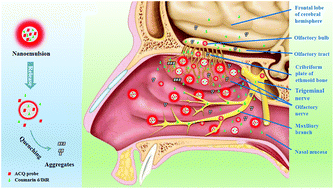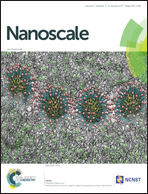Evidence of nose-to-brain delivery of nanoemulsions: cargoes but not vehicles†
Abstract
The nose-to-brain pathway has been proven to be a shortcut for direct drug delivery to the brain. However, whether and to what extent nanoparticles can be delivered through this passage is still awaiting validation with evidence. In this study, nose-to-brain transportation of nanoparticles is tracked via fluorescence bioimaging strategies using nanoemulsions (NEs) as model carriers. Identification of NEs in biological tissues is based on the on → off signal switching of a new type of environment-responsive embedded dyes, P2 and P4, and two conventional probes, DiR and coumarin-6 (C6), are embedded to represent the cargoes. Evidence for the translocation of NEs was collected either via live imaging or ex vivo histological examination in rats after nasal administration. Results suggest that NEs with a particle size of about 100 nm, either naked or coated with chitosan, have longer retention duration in nostrils and slower mucociliary clearance than larger ones. P2 signals, representing integral NEs, can be found in mucosa and trigeminal nerves for all size groups, whereas only weak P2 signals are detected in the olfactory bulb for chitosan-coated NEs of 100 nm. Confocal microscopy further confirms the translocation of integral 100 nm NEs in nasal mucosa and along the trigeminal nerve in decremental intensity. Weak signals of the P4 probe, also representing integral NEs, can be detected in the olfactory bulb but few in the brain. NEs as large as 900 nm cannot be transported to the olfactory bulb. However, the DiR or C6 signals that represent the cargoes can be found in significant amounts along the nose-to-brain pathway and finally reach the brain. Evidence shows that integral NEs can be delivered to the olfactory bulb, but few to the brain, whereas the cargoes can be released and permeated into the brain in greater amounts.


 Please wait while we load your content...
Please wait while we load your content...